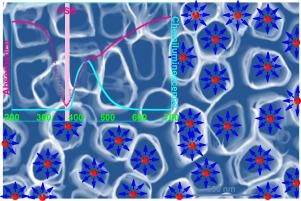当前位置:
X-MOL 学术
›
J. Electroanal. Chem.
›
论文详情
Our official English website, www.x-mol.net, welcomes your feedback! (Note: you will need to create a separate account there.)
Efficient chemiluminescence harnessing via slow photons in sensitized TiO2 nanotubes for the photoelectrochemical biosensing
Journal of Electroanalytical Chemistry ( IF 4.5 ) Pub Date : 2020-12-01 , DOI: 10.1016/j.jelechem.2020.114676 Bekir Çakıroğlu , Mahmut Özacar
Journal of Electroanalytical Chemistry ( IF 4.5 ) Pub Date : 2020-12-01 , DOI: 10.1016/j.jelechem.2020.114676 Bekir Çakıroğlu , Mahmut Özacar

|
Abstract TiO2 nanotubes (TNTs) were fabricated by anodic oxidation and the partially reduced black-TNTs (B-TNTs) were obtained by electrochemical reduction. After the sensitization of B-TNTs with thioflavin T (B-TNTs-Th-T), the photo-electrode was used as a photoelectrochemical (PEC) biosensing of glucose. The uniform porous architecture of TNTs with a high surface to volume ratio is responsible for the photo-generated charge transfer and Th-T absorption and sensitization broadened the light absorption range and intensity. The favorable matching of energy levels between Th-T and B-TNTs allowed a fast electron transfer from excited Th-T to TNTs under chemiluminescence (CL). Furthermore, the bandgap of TNTs was red-shifted after the formation of B-TNTs and the red edge of the photonic stop-band was deliberately tuned to overlap with both the bandgap of the semiconducting material and the CL emission spectrum, by leading dual enhancement effects which enhanced the photocurrent unprecedentedly mainly owing to the “slow light effect”. The photo-electrode yielded 40 times higher photocurrent compared to TiO2 thin film coated counterpart indicating effectively harnessing of CL. The biosensor has a large linear measurement range of 0.027–5 mM with a LOD of 8 μM for glucose. The phenomenon “slow light effect” will pay the way for efficient light harnessing and management for commercially available more sensitive and inexpensive PEC devices in the future.
中文翻译:

通过敏化 TiO2 纳米管中的慢光子有效利用化学发光进行光电化学生物传感
摘要 采用阳极氧化法制备TiO2纳米管(TNTs),电化学还原得到部分还原的黑色TNTs(B-TNTs)。在用硫代黄素 T (B-TNTs-Th-T) 敏化 B-TNTs 后,光电极用作葡萄糖的光电化学 (PEC) 生物传感。具有高表面积体积比的 TNT 的均匀多孔结构负责光生电荷转移,Th-T 吸收和敏化拓宽了光吸收范围和强度。Th-T 和 B-TNT 之间能级的有利匹配允许在化学发光 (CL) 下从激发的 Th-T 到 TNT 的快速电子转移。此外,在 B-TNTs 形成后,TNTs 的带隙发生红移,并且通过导致双增强效应,有意调整光子阻带的红色边缘以与半导体材料的带隙和 CL 发射光谱重叠由于“慢光效应”,光电流前所未有地增强。与涂有 TiO2 薄膜的对应物相比,光电极产生的光电流高 40 倍,表明有效利用了 CL。生物传感器具有 0.027–5 mM 的大线性测量范围,葡萄糖的 LOD 为 8 μM。“慢光效应”现象将为未来商用更灵敏、更便宜的 PEC 设备的高效光利用和管理铺平道路。通过领先的双重增强效应,前所未有地增强了光电流,这主要归功于“慢光效应”。与涂有 TiO2 薄膜的对应物相比,光电极产生的光电流高 40 倍,表明有效利用了 CL。生物传感器具有 0.027–5 mM 的大线性测量范围,葡萄糖的 LOD 为 8 μM。“慢光效应”现象将为未来商用更灵敏、更便宜的 PEC 设备的高效光利用和管理铺平道路。通过领先的双重增强效应,前所未有地增强了光电流,这主要归功于“慢光效应”。与涂有 TiO2 薄膜的对应物相比,光电极产生的光电流高 40 倍,表明有效利用了 CL。生物传感器具有 0.027–5 mM 的大线性测量范围,葡萄糖的 LOD 为 8 μM。“慢光效应”现象将为未来商用更灵敏、更便宜的 PEC 设备的高效光利用和管理铺平道路。027–5 mM,葡萄糖的 LOD 为 8 μM。“慢光效应”现象将为未来商用更灵敏、更便宜的 PEC 设备的高效光利用和管理铺平道路。027–5 mM,葡萄糖的 LOD 为 8 μM。“慢光效应”现象将为未来商用更灵敏、更便宜的 PEC 设备的高效光利用和管理铺平道路。
更新日期:2020-12-01
中文翻译:

通过敏化 TiO2 纳米管中的慢光子有效利用化学发光进行光电化学生物传感
摘要 采用阳极氧化法制备TiO2纳米管(TNTs),电化学还原得到部分还原的黑色TNTs(B-TNTs)。在用硫代黄素 T (B-TNTs-Th-T) 敏化 B-TNTs 后,光电极用作葡萄糖的光电化学 (PEC) 生物传感。具有高表面积体积比的 TNT 的均匀多孔结构负责光生电荷转移,Th-T 吸收和敏化拓宽了光吸收范围和强度。Th-T 和 B-TNT 之间能级的有利匹配允许在化学发光 (CL) 下从激发的 Th-T 到 TNT 的快速电子转移。此外,在 B-TNTs 形成后,TNTs 的带隙发生红移,并且通过导致双增强效应,有意调整光子阻带的红色边缘以与半导体材料的带隙和 CL 发射光谱重叠由于“慢光效应”,光电流前所未有地增强。与涂有 TiO2 薄膜的对应物相比,光电极产生的光电流高 40 倍,表明有效利用了 CL。生物传感器具有 0.027–5 mM 的大线性测量范围,葡萄糖的 LOD 为 8 μM。“慢光效应”现象将为未来商用更灵敏、更便宜的 PEC 设备的高效光利用和管理铺平道路。通过领先的双重增强效应,前所未有地增强了光电流,这主要归功于“慢光效应”。与涂有 TiO2 薄膜的对应物相比,光电极产生的光电流高 40 倍,表明有效利用了 CL。生物传感器具有 0.027–5 mM 的大线性测量范围,葡萄糖的 LOD 为 8 μM。“慢光效应”现象将为未来商用更灵敏、更便宜的 PEC 设备的高效光利用和管理铺平道路。通过领先的双重增强效应,前所未有地增强了光电流,这主要归功于“慢光效应”。与涂有 TiO2 薄膜的对应物相比,光电极产生的光电流高 40 倍,表明有效利用了 CL。生物传感器具有 0.027–5 mM 的大线性测量范围,葡萄糖的 LOD 为 8 μM。“慢光效应”现象将为未来商用更灵敏、更便宜的 PEC 设备的高效光利用和管理铺平道路。027–5 mM,葡萄糖的 LOD 为 8 μM。“慢光效应”现象将为未来商用更灵敏、更便宜的 PEC 设备的高效光利用和管理铺平道路。027–5 mM,葡萄糖的 LOD 为 8 μM。“慢光效应”现象将为未来商用更灵敏、更便宜的 PEC 设备的高效光利用和管理铺平道路。



























 京公网安备 11010802027423号
京公网安备 11010802027423号